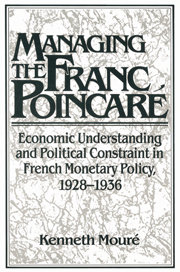 Managing the Franc Poincaré
Managing the Franc Poincaré Book contents
- Frontmatter
- Contents
- List of figures and tables
- Acknowledgments
- Abbreviations used in the notes
- Introduction
- 1 The depression in France
- 2 French gold accumulation, 1928–1932
- 3 The World Economic Conference and the gold bloc
- 4 The Bank of France: market control and interest-rate policy
- 5 The Treasury and government finance
- 6 The devaluation debate
- 7 Devaluation of the franc
- Conclusion
- Appendix
- Bibliography
- Index
2 - French gold accumulation, 1928–1932
Published online by Cambridge University Press: 23 November 2009
- Frontmatter
- Contents
- List of figures and tables
- Acknowledgments
- Abbreviations used in the notes
- Introduction
- 1 The depression in France
- 2 French gold accumulation, 1928–1932
- 3 The World Economic Conference and the gold bloc
- 4 The Bank of France: market control and interest-rate policy
- 5 The Treasury and government finance
- 6 The devaluation debate
- 7 Devaluation of the franc
- Conclusion
- Appendix
- Bibliography
- Index
Summary
While observers in France believed the origins of the depression lay in the monetary policies of the Anglo-Saxon nations, observers abroad attacked France for deliberately drawing gold to exercise political leverage in Europe, aggravating the depression by forcing monetary contractions in the countries losing gold. From 1928 to 1932, French gold reserves increased by more than 50 billion francs, from 29 to 82 billion francs. During the same period, Bank of France note circulation increased by only 22 billion francs. This extraordinary gold accumulation and apparent sterilization attracted widespread criticism, particularly from Britain, where the pound sterling, backed by a comparatively small gold reserve, was threatened and eventually forced off the gold standard. Even moderate opinion judged French gold policy irresponsible, having insufficient regard for its repercussions abroad. In the Macmillan Committee's discussion of the international gold problem and means to relieve it, Keynes remarked, “It is very doubtful how far the Bank of France is aware either of the existence of the problem or of the nature of the solution”.
This chapter examines French gold accumulation and the international gold problem in two stages. After a brief explanation of the requirements of the monetary law of 25 June 1928 and initial French behavior under the new monetary regime, the first section examines Franco-British discussions of the gold flow from London to Paris and the attempts to ameliorate it in 1930 and 1931. The second section deals with French assistance to Britain during the sterling crisis in 1931 and the changes in Bank of France gold and foreign exchange policy after sterling went off gold.
- Type
- Chapter
- Information
- Managing the Franc PoincaréEconomic Understanding and Political Constraint in French Monetary Policy, 1928–1936, pp. 46 - 79Publisher: Cambridge University PressPrint publication year: 1991
- 2
- Cited by
